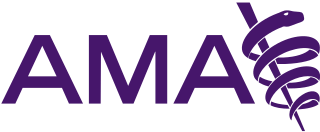Related Research Articles
A health system, health care system or healthcare system is an organization of people, institutions, and resources that delivers health care services to meet the health needs of target populations.

The American Medical Association (AMA) is an American professional association and lobbying group of physicians and medical students. Founded in 1847, it is headquartered in Chicago, Illinois. Membership was 271,660 in 2022.

In the United Nations, the Millennium Development Goals (MDGs) were eight international development goals for the year 2015 created following the Millennium Summit, following the adoption of the United Nations Millennium Declaration. These were based on the OECD DAC International Development Goals agreed by Development Ministers in the "Shaping the 21st Century Strategy". The Sustainable Development Goals (SDGs) succeeded the MDGs in 2016.
Community health refers to non-treatment based health services that are delivered outside hospitals and clinics. Community health is a subset of public health that is taught to and practiced by clinicians as part of their normal duties. Community health volunteers and community health workers work with primary care providers to facilitate entry into, exit from and utilization of the formal health system by community members as well as providing supplementary services such as support groups or wellness events that are not offered by medical institutions.

The United States President's Emergency Plan For AIDS Relief (PEPFAR) is a United States governmental initiative to address the global HIV/AIDS epidemic and help save the lives of those suffering from the disease. Launched by U.S. President George W. Bush in 2003, as of May 2020, PEPFAR has provided about $90 billion in cumulative funding for HIV/AIDS treatment, prevention, and research since its inception, making it the largest global health program focused on a single disease in history until the COVID-19 pandemic. PEPFAR is implemented by a combination of U.S. government agencies in over 50 countries and overseen by the Global AIDS Coordinator at the United States Department of State. As of 2023, PEPFAR has saved over 25 million lives, primarily in sub-Saharan Africa.
QAD Inc. is a software company that provides enterprise resource planning (ERP) software and related enterprise software to manufacturing companies. The company has customers in over 100 countries around the world.
Health equity arises from access to the social determinants of health, specifically from wealth, power and prestige. Individuals who have consistently been deprived of these three determinants are significantly disadvantaged from health inequities, and face worse health outcomes than those who are able to access certain resources. It is not equity to simply provide every individual with the same resources; that would be equality. In order to achieve health equity, resources must be allocated based on an individual need-based principle.

A free clinic or walk in clinic is a health care facility in the United States offering services to economically disadvantaged individuals for free or at a nominal cost. The need for such a clinic arises in societies where there is no universal healthcare, and therefore a social safety net has arisen in its place. Core staff members may hold full-time paid positions, however, most of the staff a patient will encounter are volunteers drawn from the local medical community.

Health human resources (HHR) – also known as human resources for health (HRH) or health workforce – is defined as "all people engaged in actions whose primary intent is to enhance positive health outcomes", according to World Health Organization's World Health Report 2006. Human resources for health are identified as one of the six core building blocks of a health system. They include physicians, nursing professionals, pharmacists, midwives, dentists, allied health professions, community health workers, and other social service and health care providers.

The human immunodeficiency virus (HIV) is a retrovirus that attacks the immune system. It can be managed with treatment. Without treatment it can lead to a spectrum of conditions including acquired immunodeficiency syndrome (AIDS).
A health professional, healthcare professional, or healthcare worker is a provider of health care treatment and advice based on formal training and experience. The field includes those who work as a nurse, physician, physician assistant, registered dietitian, veterinarian, veterinary technician, optometrist, pharmacist, pharmacy technician, medical assistant, physical therapist, occupational therapist, dentist, midwife, psychologist, audiologist, or healthcare scientist, or who perform services in allied health professions. Experts in public health and community health are also health professionals.

Tropical diseases, especially malaria and tuberculosis, have long been a public health problem in Kenya. In recent years, infection with the human immunodeficiency virus (HIV), which causes acquired immune deficiency syndrome (AIDS), also has become a severe problem. Estimates of the incidence of infection differ widely.

As of 2012, approximately 1,100,000 people in Malawi are HIV-positive, which represents 10.8% of the country's population. Because the Malawian government was initially slow to respond to the epidemic under the leadership of Hastings Banda (1966–1994), the prevalence of HIV/AIDS increased drastically between 1985, when the disease was first identified in Malawi, and 1993, when HIV prevalence rates were estimated to be as high as 30% among pregnant women. The Malawian food crisis in 2002 resulted, at least in part, from a loss of agricultural productivity due to the prevalence of HIV/AIDS. Various degrees of government involvement under the leadership of Bakili Muluzi (1994–2004) and Bingu wa Mutharika (2004–2012) resulted in a gradual decline in HIV prevalence, and, in 2003, many people living in Malawi gained access to antiretroviral therapy. Condoms have become more widely available to the public through non-governmental organizations, and more Malawians are taking advantage of HIV testing services.

Healthcare in the United States is largely provided by private sector healthcare facilities, and paid for by a combination of public programs, private insurance, and out-of-pocket payments. The U.S. is the only developed country without a system of universal healthcare, and a significant proportion of its population lacks health insurance. The United States spends more on healthcare than any other country, both in absolute terms and as a percentage of GDP; however, this expenditure does not necessarily translate into better overall health outcomes compared to other developed nations. Coverage varies widely across the population, with certain groups, such as the elderly and low-income individuals, receiving more comprehensive care through government programs such as Medicaid and Medicare.

HIV Resistance Response Database Initiative (RDI) was formed in 2002 to use artificial intelligence (AI) to predict how patients will respond to HIV drugs using data from more 250,000 patients from around 50 countries around the world.
Healthcare in Malawi and its limited resources are inadequate to fully address factors plaguing the population, including infant mortality and the very high burden of diseases, especially HIV/AIDS, malaria and tuberculosis.
Seed Global Health, formerly known as Global Health Service Corps, is a non-profit organization started in 2011 which helps to provide nursing and medical training support in resource-limited countries. Seed Global Health collaborates with the Peace Corps to create the Global Health Service Partnership (GHSP). This program has established the first "Peace Corps for doctors and nurses". Since launch, GHSP has had 97 volunteers train more than 8,300 students in 5 African countries.

PharmAccess Foundation is a part of the PharmAccess Group. PharmAccess is an international non-profit organization with a digital agenda dedicated to connecting more people in sub-Saharan Africa to better healthcare. By making use of public-private partnerships, they leverage donor contributions, which they believe will pave the way for private investments thereby contributing to healthier populations and social and economic development. Currently, PharmAccess employs a multidisciplinary team of professionals in Tanzania, Kenya, Nigeria, Ghana and the Netherlands.

Cultural competence in healthcare refers to the ability for healthcare professionals to demonstrate cultural competence toward patients with diverse values, beliefs, and feelings. This process includes consideration of the individual social, cultural, and psychological needs of patients for effective cross-cultural communication with their health care providers. The goal of cultural competence in health care is to reduce health disparities and to provide optimal care to patients regardless of their race, gender, ethnic background, native languages spoken, and religious or cultural beliefs. Cultural competency training is important in health care fields where human interaction is common, including medicine, nursing, allied health, mental health, social work, pharmacy, oral health, and public health fields.
Andrew Ddungu Kambugu is a Ugandan physician who serves as The Sande-McKinnell Executive Director at Uganda Infectious Disease Institute and a Honorary Senior lecturer at Makerere University College of Sciences. He is also an Adjunct Associate Professor at the University of Minnesota. In July 2020, he was appointed to the United Nations 2021 Food System Scientific Group.
References
- ↑ Miguel Palacios (16 December 2002). "Human Capital Contracts "Equity-like" Instruments for Financing Higher Education". Policy Analysis (462).
- ↑ Palacios, Miguel. Investing in Human Capital. Cambridge University Press, 2004. ISBN 0-521-03952-5
- ↑ "Human Capital Contracts 'Equity-like' Instruments for Financing Higher Education" (PDF).
- ↑ "Archived copy" (PDF). Archived from the original (PDF) on 2012-10-18. Retrieved 2012-01-13.
{{cite web}}: CS1 maint: archived copy as title (link) - ↑ "Yale to Erase Alumni Debts In 2 Loan Plans", The New York Times, April 13, 1999
- ↑ Michael Simkovic, Risk-Based Student Loans (2012)
- ↑ "frugaltopia.com". www.frugaltopia.com.
- ↑ "Align Income Share Funding | Better Than a Personal Loan".
- ↑ "Healthcare Reform: Solving the Medical Student Debt Crisis Through Human Capital Contracts" By Anand Reddi and Andreas Thyssen, The Huffington Post, June 10, 2011
- ↑ Reddi, A.; Thyssen, A.; Smith, D.; Lange, J. H.; Akileswaran, C. (2012). "Human capital contracts for global health: a plan to increase the number of physicians in resource limited settings". AIDS. 26 (15): 1979–1980. doi:10.1097/QAD.0b013e32835857d4. PMID 22992581.
- ↑ Reddi, A.; Thyssen, A.; Smith, D.; Lange, J. H.; Akileswaran, C. (2012). "Human capital contracts for global health: a plan to increase the number of physicians in resource limited settings". AIDS. 26 (15): 1979–1980. doi:10.1097/QAD.0b013e32835857d4. PMID 22992581.
- ↑ Reddi, A.; Thyssen, A.; Smith, D.; Lange, J. H.; Akileswaran, C. (2012). "Human capital contracts for global health: a plan to increase the number of physicians in resource limited settings". AIDS. 26 (15): 1979–1980. doi:10.1097/QAD.0b013e32835857d4. PMID 22992581.
- ↑ Reddi, A.; Thyssen, A.; Smith, D.; Lange, J. H.; Akileswaran, C. (2012). "Human capital contracts for global health: a plan to increase the number of physicians in resource limited settings". AIDS. 26 (15): 1979–1980. doi:10.1097/QAD.0b013e32835857d4. PMID 22992581.
- ↑ "Home". fixuc.org.
- ↑ Reddi A, Thyssen A, Smith D, Lange JH, Akileswaran C (September 2012). "Human capital contracts for global health: a plan to increase the number of physicians in resource limited settings". AIDS. 26 (15): 1979–80. doi: 10.1097/QAD.0b013e32835857d4 . PMID 22992581.
{{cite journal}}: CS1 maint: multiple names: authors list (link) - ↑ "Thoughts on Human Capital Contracts". December 2010.
- ↑ "Private Site".
- ↑ "Home / StepEx".